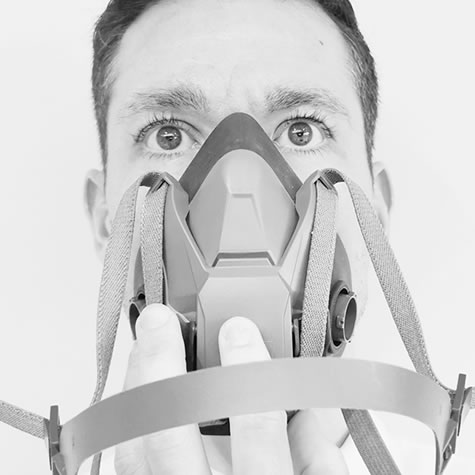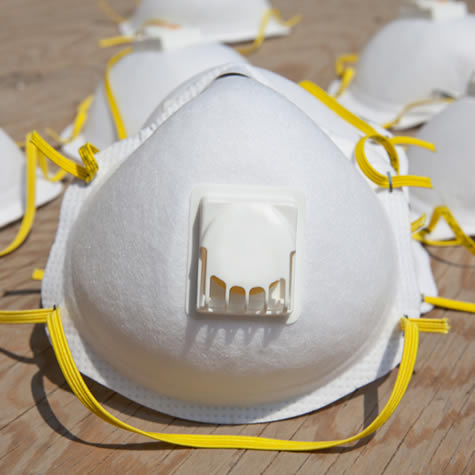Qualitative Face-Fit Testing In Weston-super-mare
On Site Face Fit Testing In Weston-super-mare
If your company is based in Weston-super-mare and you require qualitative face-fit testing for your employees, we at Fire Coral Ltd can provide you with testing by a Fit2Fit accredited provider.
As part of your company health and safety remit, if you provide your staff with respiratory equipment (RPE) you require certification that they fit your staff correctly, are used in the correct manner, and maintained in line with legal requirements. The Health & Safety Executives (HSE) guidance note INDG 479 lays bare the need for face fit testing.
Face-fit testing is required, especially if your employees work in a dusty environment within Weston-super-mare. The COSHH (Control of Substances Hazardous to Health) Regulations state then when selecting RPE equipment, a face-fit test is a way of ensuring an adequate seal is achieved. Did you know over 50% of masks tested on those with no training failed a face fit test.
By following the guidance laid out in INDG 479 & HSG 53 with regards RPE, you are meeting the regulatory requirements expected of you.
Book Your Face Fit Testing Today
Give us a call to discuss face-fit testing your employees in Weston-super-mare
Qualitative Face Fit Testing Firm That Covers Weston-super-mare
All close fitting masks should be face fit tested on the wearer to demonstrate whether they work or not. The types of masks which would need face-fit testing include, disposable face masks (FFP3), half masks & full-face masks. Here at Fire Coral Ltd, we provide qualitative testing for workers in Weston-super-mare using half-face disposable or reusable masks only.
Weston-super-mare Face Fit Testing
A face fit test is a set of exercises simulating everyday movement to determine whether an adequate seal is maintained. There are 7 exercises which each staff member should complete, each lasting for 1 minute. If one of the exercises is failed, the whole test needs to be re-taken. We will test your staff in groups of nine in slots 1.5 hours apart to minimise downtime to yourselves.
On Site Face Fit Testing Companies That Cover Weston-super-mare
Normal working conditions should be simulated during the test, as mentioned in INDG 479. It is recommended that staff should be using dynamic movements such as walking, stepping and cycling on exercise machines.
If your staff in Weston-super-mare use RPE on a regular basis, and you would like to ensure they are fully trained in the wearing, fitting, and use of their respiratory equipment; Fire Coral Ltd can provide you with a tailored training package at a preferential rate.
About Weston-super-mare
Weston-super-Mares prominence as a thriving seaside resort can be traced back to Victorian times when people flocked to the town in their droves to sample its magical healing powers.With its fresh sea air and saltwater bathing, it was regarded as a health spa by doctors who advocated the benefits of both drinking and bathing in salt water and also of inhaling the seaside air. Westons air was described as being excellent for healing while the water was thought to have magical powers. The combination led people to escape from their smog-filled factories and cities and head to the North Somerset coastal town for a healthy break for a week each year.Weston capitalised on its new-found popularity. The towns first hotel, which is now part of the Royal Hotel, opened in 1810 and ten years later John Howe who bought Knightstone Island for £200 opened his spa baths on the island.Howes Baths comprised of hot and cold salt water baths as well as accommodation for the invalids and a refreshment room and reading room. Around this time it was the fashion to swim naked so the beaches were segregated into mens and womens areas with the first ladies beach being at the secluded Anchor Cove.Later on, to protect bathers modesty, swimmers stepped into the sea in Victorian bathing machines. These carts, which were like small portable beach huts on wheels, allowed swimmers to wade into the water where, once deep enough, the occupant would disembark into the water before returning to the bathing machine to walk back to the shore and dress after their swim.Westons reputation as a health spa resort continued when Dr Edward Long Fox, a pioneer in the treatment of physical and mental disorders, set up a centre on Knightstone Island in 1830. The island, which is attached to the mainland by a causeway, now houses the Dr Foxs Tea Room in his honour.As well as lapping up the health benefits Weston had to offer, visitors were also enjoying the other attractions which came as bi-products of the towns popularity. Weston was now unrecognisable from the small fishing settlement of around 30 houses that it had grown up as before King George III extolled the virtues of sea bathing and sea air as the way to go after a visit to the Dorset town of Weymouth.The railway arrived in Weston in 1841 bringing in even more holiday makers but to begin with the carriages had to be drawn part of the way by horses because some residents complained they did not want noisy steam engines.Another huge influx of visitors arrived by paddle steamers from Wales when Birnbeck Pier opened in 1867. But the pier was much more than just a landing jetty. On a typical Bank Holiday up to 15,000 people would arrive by boat to enjoy the piers other attractions such as a theatre of wonders, mechanical models and shooting gallery. The Victorians love-affair with the sea and their wish to get even closer to it, especially when the tide was out, led them to build a second promontory and the town centre Grand Pier was opened in 1904. It was soon extended a further 450 metres into the water with the intention of running a regular passenger boat service to Cardiff but this plan was abandoned when they realised it was impossible to have a regular timetable because Weston has the second highest tidal range in the world. The extension to the pier was soon dismantled and the pier was just reserved for entertainment.The growth of the more central Grand Pier with its attractions and entertainment hall led to Birnbeck Piers demise. It was taken over by the military during the Second World War and became HMS Birnbeck – a site for important military research and weapons testing. Among the scientists based there was Barnes Wallis, the inventor of the bouncing bomb. Early tests for that weapon which skipped across the water before hitting its target, were carried out at Birnbeck.With Birnbeck and the Weston coastline from Brean Down to Sand Point being used for military research and testing, as well as the proximity of Weston airfield, the town was a target for enemy fire during WW2. That was despite having more than 6,000 women and children evacuated to the town in 1939 from cities such as London and Bristol because it was thought they would be safer.But Weston was the target of bombing raids. Some 129 people lost their lives and more than 1,000 were injured in raids and large areas were destroyed. The towns wartime links dont end there. In 1914 Weston artist Alfred Leetes drawing of Lord Kitchener was adapted into the famous Your Country Needs You recruitment poster campaign. Indeed Weston played an active role in the First World War. A large number of soldiers were billeted there for training where they learned how to dig trenches on the beach. Furthermore, around 80 per cent of the trees in Weston Woods were chopped down for military purposes. With men being redirected elsewhere, Weston had the first female tram driver in the country in Beatrice Page. She was one of several women recruited to operate the trams in place of the menfolk who had gone to war. Although Weston has always been best known as a seaside town, the growth of its development encouraged new business and Weston was also known for brickmaking and pottery.Weston had been booming before the Second World War to such an extent that in 1936 it opened its own airfield and a year later, on the Whitsun holiday, 2,555 passengers travelled on Western Airways from Weston Airport as the route became one of the busiest short haul routes in the UK.It wasnt Westons first association with aviation. Bentfield Charles Hucks made history when he became the first aviator to fly over the Bristol Channel when he took his Blackburn monoplane on a return flight from Weston to Cardiff in 1911.Weston was by now used to being a place for pioneers. The island of Flat Holm, which lies just off the bay, became assured of its place in history when the worlds first radio transmission across water was made from there by Italian Guglielmo Marconi in 1897 when his signals were received in Wales.As well as owning that piece of history, Flat Holm was used as an isolation hospital to protect the mainland from a cholera epidemic in 1883.But it is for tourism that Weston-super-Mare, an amalgamation of the Anglo Saxon word for town and the Latin for above the sea, is best known.One of the resorts best known attractions, the Grand Pier, had to be rebuilt following a fire in 2008 while Birnbeck Pier has fallen into disrepair and is now out of bounds. Although the piers were originally built to bring people closer to the water the Marine Lake was created in 1927 to ensure that bathers could still enjoy the water when the tide is out.Weston is also assured its place in musical history. The Beatles Victorian swimwear shoot was performed while they were on their 1963 six-day trip to Weston where they performed twice a day at the Odeon. Meanwhile, the sleeve for Oasis single Roll With It was shot on Weston beach and a teenage Diana Dors once took part in a beauty pageant at the Tropicana when it was still being used as a Lido.Westons history is rich and diverse ..rather like the town and all its attractions.




